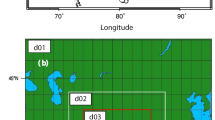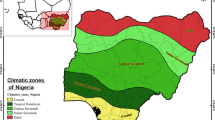Abstract
Heatwaves are a major cause of environmental and health hazards. In a global warming scenario, the effect of heat stress associated with the increased frequency of heatwaves makes a large number of people vulnerable over the Indian subcontinent. For the development of a proper heatwave action plan in this region, heatwaves are required to be monitored, tracked, and predicted in real-time. In this study, we propose an operationally deployable empirical model using a set of indices to monitor and predict the heatwaves in the short range over the Indian region in real-time using gridded observation data and reanalysis data. The empirical operational model framework has two major components, (a) index-based monitoring over a spatial domain, and (b) temporal prediction over different locations (i.e. grid points). In the current version of the model framework, three heatwave indices are calculated for component (a), e.g., excess heat index, heat stress index, and excess heat factor index which were found suitable for the Indian region, and elsewhere. The advantage of these percentile-based and mean monthly exceedance-based indices is that they can be used to identify the heatwave affected blocks/districts/cities masking the local fluctuations. In addition, we also incorporate the effect of synoptic information like wind and humidity on heatwave intensity and duration in this component. This model component closely follows the existing operational criteria and the results from several cases are verified. For the second component (b), we have used a simple machine learning based method for the prediction of excess heat factor index to understand the recurrence properties of these indices. This simplistic method provides some reference skills for heatwave based on evolution memories. The results indicate that the overall heatwave indices can be predicted using this simplistic model up to a lead-time of 2–3 days for most of the regions of India.












taken from Fig. 9. The black curve shows the EHF from observation. Forecasts for different lead-times are also shown
Similar content being viewed by others
References
Chakraborty D, Sehgal VK, Dhakar R et al (2019) Spatio-temporal trend in heat waves over India and its impact assessment on wheat crop. Theoret Appl Climatol 138:1925–1937. https://doi.org/10.1007/s00704-019-02939-0
Deryng D, Conway D, Ramankutty N et al (2014) Global crop yield response to extreme heat stress under multiple climate change futures. Environ Res Lett 9:034011. https://doi.org/10.1088/1748-9326/9/3/034011
Dubey AK, Lal P, Kumar P et al (2021) Present and future projections of heatwave hazard-risk over India: A regional earth system model assessment. Environ Res 201:111573. https://doi.org/10.1016/j.envres.2021.111573
Emmert-Streib F, Yang Z, Feng H, et al (2020) An introductory review of deep learning for prediction models with big data. Front Artif Intell 3
Fischer EM, Schär C (2010) Consistent geographical patterns of changes in high-impact European heatwaves. Nat Geosci 3:398–403. https://doi.org/10.1038/ngeo866
Fischer EM, Lawrence DM, Sanderson BM (2011) Quantifying uncertainties in projections of extremes—a perturbed land surface parameter experiment. Clim Dyn 37:1381–1398. https://doi.org/10.1007/s00382-010-0915-y
Gers FA, Schmidhuber J, Cummins F (1999) Learning to forget: continual prediction with LSTM. In: 1999 Ninth international conference on artificial neural networks ICANN 99. (Conf. Publ. No. 470), vol 2, pp 850–855
Guleria S, Gupta AK (2018) Heat wave in India documentation of state of Telangana and Odisha (2016). National Institute of Disaster Management, New Delhi. https://nidm.gov.in/PDF/pubs/heat_wave_18.pdf (last accessed 01July2022)
Hatfield JL, Prueger JH (2015) Temperature extremes: effect on plant growth and development. Weather Clim Extrem 10:4–10. https://doi.org/10.1016/j.wace.2015.08.001
Hochreiter S, Schmidhuber J (1997) Long short-term memory. Neural Comput 9:1735–1780. https://doi.org/10.1162/neco.1997.9.8.1735
Lees AM, Sejian V, Wallage AL et al (2019) The impact of heat load on cattle. Animals (Basel) 9:322. https://doi.org/10.3390/ani9060322
Masson-Delmotte V, Zhai P, Portner H-O, et al (2018) Global warming of 1.5°C. An IPCC Special Report on the impacts of global warming of 1.5°C above pre-industrial levels and related global greenhouse gas emission pathways, in the context of strengthening the global response to the threat of climate change, sustainable development, and efforts to eradicate poverty
McCarthy M, Armstrong L, Armstrong N (2019) A new heatwave definition for the UK. Weather 74:382–387. https://doi.org/10.1002/wea.3629
Miao K, Han T, Yao Y et al (2020) Application of LSTM for short term fog forecasting based on meteorological elements. Neurocomputing 408:285–291. https://doi.org/10.1016/j.neucom.2019.12.129
Nairn J, Fawcett R (2013) Defining heatwaves: heatwave defined as a heatimpact event servicing all community and business sectors in Australia. CSIRO and the Bureau of Meteorology, Australia
Nairn J, Fawcett R, Ray D (2009) Defining and predicting excessive heat events, a national system. CAWCR, Melbourne
Nissan H, Burkart K, Coughlan de Perez E et al (2017) Defining and predicting heat waves in Bangladesh. J Appl Meteorol Climatol 56:2653–2670. https://doi.org/10.1175/JAMC-D-17-0035.1
Omid M, Amir AghaKouchak, Davis SJ et al (2017) Increasing probability of mortality during Indian heat waves. Sci Adv 3:e1700066. https://doi.org/10.1126/sciadv.1700066
Ouma YO, Cheruyot R, Wachera AN (2022) Rainfall and runoff time-series trend analysis using LSTM recurrent neural network and wavelet neural network with satellite-based meteorological data: case study of Nzoia hydrologic basin. Complex Intell Syst 8:213–236. https://doi.org/10.1007/s40747-021-00365-2
Pai DS, Nair SA, Ramanathan AN (2013) Long term climatology and trends of heat waves over India during the recent 50 years (1961–2010). Mausam 64:585–604
Panda DK, Mishra A, Kumar A et al (2014) Spatiotemporal patterns in the mean and extreme temperature indices of India, 1971–2005. Int J Climatol 34:3585–3603. https://doi.org/10.1002/joc.3931
Perkins SE, Alexander LV (2013) On the measurement of heat waves. J Clim 26:4500–4517. https://doi.org/10.1175/JCLI-D-12-00383.1
Perkins-Kirkpatrick SE, Lewis SC (2020) Increasing trends in regional heatwaves. Nat Commun 11:3357. https://doi.org/10.1038/s41467-020-16970-7
Rani SI, Arulalan T, George JP et al (2021) IMDAA: high-resolution satellite-era reanalysis for the Indian monsoon region. J Clim 34:5109–5133. https://doi.org/10.1175/JCLI-D-20-0412.1
Rohini P, Rajeevan M, Srivastava AK (2016) On the variability and increasing trends of heat waves over India. Sci Rep 6:26153. https://doi.org/10.1038/srep26153
Satyanarayana GCh, Rao DVB (2020) Phenology of heat waves over India. Atmos Res 245:105078. https://doi.org/10.1016/j.atmosres.2020.105078
Siebert S, Ewert F (2014) Future crop production threatened by extreme heat. Environ Res Lett 9:041001. https://doi.org/10.1088/1748-9326/9/4/041001
Srivastava AK, Rajeevan M, Kshirsagar SR (2009) Development of a high resolution daily gridded temperature data set (1969–2005) for the Indian region. Atmos Sci Lett 10:249–254. https://doi.org/10.1002/asl.232
Van Houdt G, Mosquera C, Nápoles G (2020) A review on the long short-term memory model. Artif Intell Rev 53:5929–5955. https://doi.org/10.1007/s10462-020-09838-1
Villa DL (2021) Institutional heat wave analysis by building energy modeling fleet and meter data. Energy Build 237:110774. https://doi.org/10.1016/j.enbuild.2021.110774
Vitali A, Felici A, Esposito S et al (2015) The effect of heat waves on dairy cow mortality. J Dairy Sci 98:4572–4579. https://doi.org/10.3168/jds.2015-9331
Yu Y, Si X, Hu C, Zhang J (2019) A review of recurrent neural networks: LSTM cells and network architectures. Neural Comput 31:1235–1270. https://doi.org/10.1162/neco_a_01199
Acknowledgements
Authors acknowledge the anonymous Reviewer/s for constructive comments. The authors acknowledge Head CRS, IMD his support and encouragement. Authors also gratefully acknowledge NCMRWF, Ministry of Earth Sciences, Government of India, for IMDAA reanalysis. IMDAA reanalysis was produced under the collaboration between UK Met Office, NCMRWF, and IMD with financial support from the Ministry of Earth Sciences, under the National Monsoon Mission Program.
Author information
Authors and Affiliations
Corresponding author
Ethics declarations
Conflict of interest
Authors declare that there is no conflict of interest.
Additional information
Publisher's Note
Springer Nature remains neutral with regard to jurisdictional claims in published maps and institutional affiliations.
Rights and permissions
About this article
Cite this article
Narkhede, N., Chattopadhyay, R., Lekshmi, S. et al. An empirical model-based framework for operational monitoring and prediction of heatwaves based on temperature data. Model. Earth Syst. Environ. 8, 5665–5682 (2022). https://doi.org/10.1007/s40808-022-01450-2
Received:
Accepted:
Published:
Issue Date:
DOI: https://doi.org/10.1007/s40808-022-01450-2




